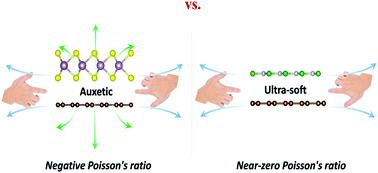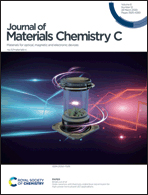Negative and near-zero Poisson's ratios in 2D graphene/MoS2 and graphene/h-BN heterostructures†
Abstract
Negative and near-zero Poisson's ratio materials are mechanical metamaterials that host an improved strain energy absorption property with respect to conventional materials. By using first-principles calculations, we report the negative and near-zero Poisson's ratios in van der Waals (vdW) heterostructures, such as graphene/hexagonal molybdenum disulfide (G/MoS2) and graphene/hexagonal boron nitride (G/h-BN), sharing distinct crystal structures from all other known negative and near-zero Poisson's ratio materials. However, the Poisson's ratios of the interfacial layer in bilayer MoS2 and h-BN are positive and near-zero along the out-of-plane direction, respectively, which are quite different from the Poisson's ratios of G/MoS2 and G/h-BN heterostructures. Therefore, these behaviors are unique to vdW heterostructures. We attribute these negative Poisson's ratio behaviors to the special interaction of pz orbitals between the interfacial layers. Furthermore, we observed among them high-order elastic constants in the out-of-plane direction, which exhibit nonlinear stress–strain responses. These results are significant for the preparation of G/h-BN and G/MoS2 heterostructures. The combinations of tunable negative/near-zero Poisson's ratios with the excellent electrical/optical properties of G/MoS2 and G/h-BN heterostructures will pave the way to a wide range of applications in novel auxetic molecular sieves and electrodes.



 Please wait while we load your content...
Please wait while we load your content...